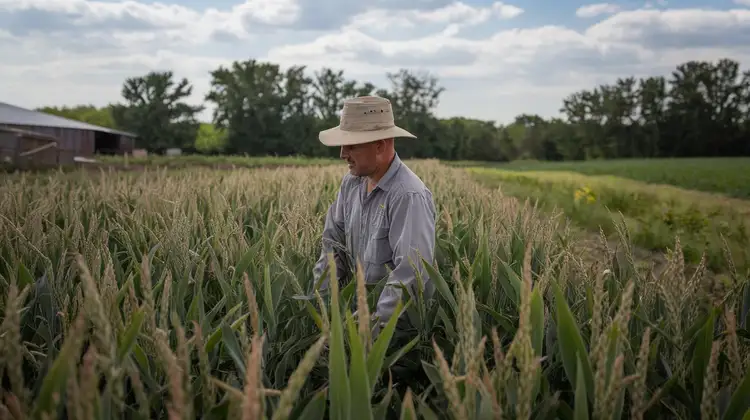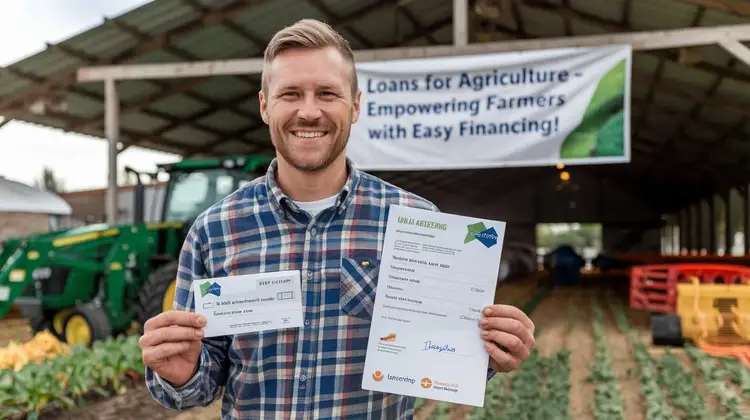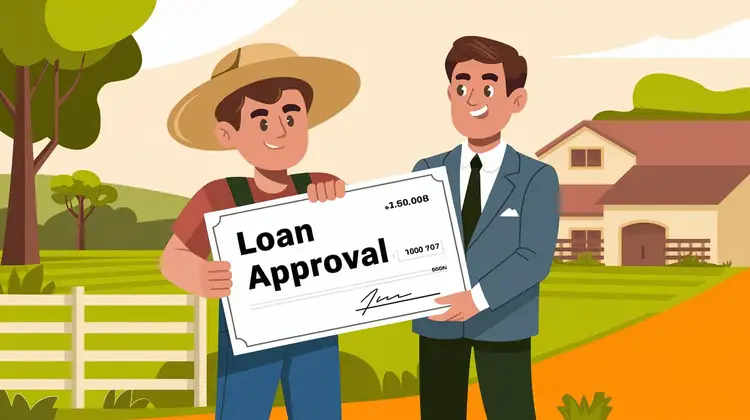Best Agriculture Loans – Flexible Funding for Farmers
Published: 21 Sep 2025
Agriculture Loans is the economic mainstay of many countries across the globe particularly to the developing world where most of the population depends on agriculture. But in order for farmers to remain in business of growing crops, enhancing their yields and own businesses, they require funding. Agriculture loans are a type of financial products aimed at reviving lending for agricultural means, crucial in funding agricultural operations and help farmers expand their enterprises, acquire machinery and enhance yields. Consequently, this article will discuss various categories of loans extended to farmers, why farmers benefit from the loans and how they empower farmers.
1. What are Loan Agriculture?
Agriculture loans are one of the financial services offered with special focus on meeting farmers needs when it comes to farming. These loans can include seeds, fertilizers, equipment, livestock or any land related needs such as wages, utilities amongst others. They can also assist in other unforeseen situations including the disasters, unfavorable climate or changing market rates.

Farming mostly has fluctuating rhythms, revenue is dependent on the seasons and many other periods in the year. Hence, a large part of credit purchases in agriculture is effective in helping farmers continue with their activities and even scale up production. These loans are essential for development defects it is important that the agricultural sector receive a constant inflow of capital to maintain productivity and hence economic stability.
2. Types of Agricultural Loans
The common type of agricultural financing includes the following; Each of these loans has its unique purpose within the farming sector. Knowledge of it will enable farmers to distinguish the most appropriate financing scheme.
2.1 Short-term Loans
They include Working capital loans and seasonal loans because they are usually intended for the funding of operation expenses or for the bridging of the cash flow gap that is experienced at some certain times in the year. These loans are repaid within a year or less and are often used for expenses like:
| Loan Type | Eligibility | Loan Amount |
|---|---|---|
| Crop Loan | Farmers with Cultivated Land | $1,000 – $50,000 |
| Livestock Loan | For Farmers Engaged in Animal Husbandry | $5,000 – $100,000 |
| Equipment Loan | For Agricultural Machinery and Equipment | $10,000 – $150,000 |
| Agri Business Loan | For Farm Businesses & Agribusiness Owners | $20,000 – $500,000 |
Buying seeds, feeding stuffs and chemicals for plant/control/eradication of pests.
Preserving wages during periods of most intensive farming activities
Currently, expenses for utilities expenses, equipment and other sundry expenses for short-term expenditures.
Such loans are arranged as short-term type and necessary for farmers as they may require extra money to fund some immediate necessity, for instance, in the periods facilitating planting or harvest.
2.2 Long-term Loans
Long-term loans are intended for much bigger expenditures in the farming enterprise. These loans are repaid over several years (often 5-10 years) and are used for investments such as:
Buying of land or an agricultural holding
Constructing or raising the standard Livestock and farming practices
Investing on high powered implements like tractors, combine harvestors and irrigation equipments
Such farming financial services allow farmers receive big amount of capital in order to expand the business or improve its processes. Due to the services being spread over a comparatively longer period, such loans attract a relatively lower interest compared to short-term facility.
2.3 Government Supported Agriculture Credit
Most governments offer agricultural loans for increased food production, to undertake stability in the sector and for encouraging rural development. These loans may offer:
Lower interest rates
Longer repayment terms
Some of the subheadings include; specified crops and livestock (dairy, poultry among others) and organic farming.
Loans backed by the government lower the risk involved to the lenders and thus qualified farm borrowers with poor credit or no credit file history can easily secure a loan. It can also be crucial to own such loans for farmers who are often rejected by commercial banks.

3. Perks of Agricredit
Rent loving farming has various advantages that include the following for farmers who intend to increase production, purchase technologies or deal with some economic hurdles.
3.1 Improved Productivity
It also pointed out that loans for Agriculture involve the GAP finance, which entails the provision of capital needed to buy inputs such as better quality seeds, fertilizers and state of the art machines used in farming. They lead to better yields and better farming practices and overall efficiency, which means better returns for any farmer.
3.2 Flexibility
The loans provided to farmers are usually flexible since farmers can take amount they want for short term or for a long term. Able to make various flexible repayments in order coming from various farming activities in that specific farming season.
3.3 Financial Stability
Agriculture credit financing enables them to meet with their daily subsistence needs during periods when they do not produce much. It means that farmers can be in a position to carry on their farming throughout the year without having to close down or lock out because of unfavorable market conditions that prevailed during off seasons.
3.4 Access to Modern Technology
The farmers will be in a position to put their money in to other farming technologist and implements. This might involve digging up sophisticated equipment to support the irrigation process, mechanized equipment to either supports the harvesting processes or computerized applications that help out in patterns of the weather so that planting can be effected appropriately.
3.5 Economic Empowerment
Being a source of capital, agricultural loans help farmers increase their scale of production and therefore their income. This in turn facilitates rural development, enhancement of people’s living conditions as well as the general development of the agriculture sector.
4. How to Qualify for an Agricultural Loan
Although the process of obtaining an agricultural loan may sound quite challenging, there are some of the major requirements that define farmer financing. Lenders typically look for the following criteria:
4.1 Credit History
Credit history info is sometimes used by the lenders to measure the farmer’s capability to repay the loans. Higher credit score enhances the credit score chance and one may be given a smaller APR. Nevertheless, some of the loans from the government or some of the other loans of specialization will have less stringent terms about the credit.
4.2 Farming Experience
Possession of farming experience can go a long way in getting a loan. Having a sustainable record as a farmer guaranteeing the efficiency of the agricultural enterprise results in its inclusion in the list of low-risk borrowers.
4.3 Types of land ownership or collateral
When getting an agricultural loan some of them come with certain conditions for example security in form of land or farming implements. Borrowers with fixed assets or land are more likely to get large loans particularly those for long term fixed investments.
4.4 Income and Profitability
Farmers will have their balance sheet checked on income, expense and profits that would enable lenders assess them for approval. Fixed income farmers are most likely to be granted loans. Earners with seasonal revenues would also need to prove their repaying capacity to conform to loan tenure grounded on cash flow patterns.
4.5 Purpose of the Loan
They have to clearly define the need for the loan, whether for purchases of equipments, acquisition of more land or improvement on existing infrastructure. Some of them may focus on providing funding to the fields that are most applicable to the specific improvement of a farming process and an increase in yields.

5.Agricultural loans 101 The application process for an agricultural loan
Amcivil Applying for a loan is quite easy as long as you will follow the necessary procedures as needed depending on the lender. Here’s a general guide on how to apply for an agricultural loan:
Step 1: Research Loan Options
The best way begins with learning about the kinds of cash advances that exist. It’s a great idea to compare interest rates, repayment terms and qualifications that the lender – banks, credit unions and government programs – offers.
Step 2: Prepare Documentation
You will need to gather financial documents such as:
Tax returns
Income statement, expense statement, Profit & loss statement
Land ownership documents
Business plan (if applicable)
Some of the lenders may also want to know your farming activities, such as what kind of crops or animals you produce.
Step 3: Submit Your Application
When you have all your documents you want to attach the application then submit it. Some of the places where you can apply for an overdraft are through online applications while others need face-to-face applications.
Step 4: Wait for Approval
After that, the applicant should wait for the decision on the given application received from various lenders who will analyze his/she financial standing and ability to pay the loan. This approval process can go from a few days to several weeks depending on the type of loan and the bankers.
| Loan Type | Eligibility | Loan Amount |
|---|---|---|
| Farm Development Loan | For Enhancing Farm Infrastructure | $5,000 – $100,000 |
| Greenhouse Loan | For Setting Up Greenhouses | $10,000 – $200,000 |
| Agri Input Loan | For Seeds, Fertilizers and Pesticides | $2,000 – $30,000 |
| Export Loan | For Agricultural Product Exporters | $15,000 – $300,000 |
Step 5: Accept the Loan
If you get a loan proposal, ensure you read thoroughly the fine prints before accepting it. When you are applying for a loan, you need to pay attention to the interest rate, the draw down schedule and fees.
6.Traditional agricultural loans
The most widely used type of financing in agriculture is the agricultural loans, but the farmers can try the other types of financing in case of they do not meet the requirements for the traditional loans.
6.1 Microloans
They are small loans that are normally granted with less strict requirements to borrowers especially to those who are farmers with little agricultural experiences. It is usually guaranteed by government agencies and is suitable for purchasing a piece of equipment or working capital.
6.2 Crowdfunding
Such farming activities can seek credit from other sources such as crowd funding to support specific farming activities. These platforms enable individuals make some small investment which they often get paid back in farm produces or other ways.
6.3 Peer-to-Peer Lending
In peer-to-peer lending farming data, farmer engages in borrowing of funds from other farmers rather than conventional financial organizations. This kind of home buying option may be attractive to those who can barely make it to other conventional loan types.
6.4 Agricultural Grants
Yes some government agencies and some non-profit organizations provide funds to farmers in the form of grants especially where the farmers intends to undertake development projects that are close to the heart of the funding institutions like sustainability, conservation or that seeks to adopt new technologies among others. Grants, on the other hand, may be procured in minority education with no strings attached; that is, they don’t have to be paid back.
7. Loan difficulties in Funding Agricultural Inputs
While agricultural loans can provide significant benefits, there are challenges that farmers may face when trying to secure financing:
7.1 High-Interest Rates
Liabilities that have high rates of interest can be offered to farmers with a bad credit history may make it harder to repay the credit. This was however associated with higher average effective interest rate, which would also mean higher cost of borrowing and could potentially put stretch available financial resources.
7.2 Collateral Requirements
Most loans within a particular credit facility often come along with a security attachment especially when the loan is longer tenured. These include the fact that the farmers who are disqualified from obtaining these loans are those who are credit constrained, have little assets and little or no land.

9. The Agricultural credit: the future
There is much dynamism in the farming credit front, appearing new technologies and financial products to deal with the problems of the growers. The future of loans for agriculture is in innovation and sustainability, digital solutions.
9.1 Digital Agricultural Loans
Technology has also created other approaches to new loans for farmers in cases of digital agriculture. The portals for online lending and the implementation of fintech solutions are enabling the farmers to take loans without any hitches and these existing problem areas have no or limited access to the conventional banking services. They tend to be very simple to use, have a fast approval rate and allow borrowers to obtain the funds without having to undergo through many formalities.
9.2 Subsecti Agricultural Insurance and Loan Integration
A number of these vices impact on yields such as climatic shocks or disasters, diseases or pests and market risks. On the same note, four different 5 types of agri-insurance products or tools that farmers can use alongside loans when out to minimize risks that are ever present in farming involve. For instance, in a situation where crops have been destroyed or other unlikely circumstances occur payment through insurance could assist the farmers to meet the demands of bank loans.
9.3 Agriculture Loans for Sustainable Business
As the global awareness for environment and climate change increases there is trend towards green loans as well as sustainable agricultural financing. They are geared towards funding conservation agriculture – including organic agriculture, water conservation in agriculture, use of renewable energy in agriculture and sustainable land management.
9.4 Peer to Peer Financing for Agriculture
On-line funding of agriculture industries is also another option that is gradually gaining popularity among farmers in striving to access funds. FarmDrive together with Kiva means that farmers can tap funds from different classes of investors who want to fund agriculture. This model also brings about financial inclusion which can never accessed by small scale farmers using conventional means.
10. Conclusion
Agriculture finances have always been important in providing assistance to farmers, help them increase their enterprise operations, purchase important machinery and overcome difficult unexpected situations. Everything from easier short-term cash flow to establish inventory or to finance the acquisition of assets required for the long-term, these loans help put farmers in a position to increase their business’s standards.
FAQs
Why are there agricultural loans granted by a government?
Financial mortgage offered by the government is usually cheaper, meaning lower interest rates as well as offer flexible grace period. They also minimise the risks to funders and are thus available to farmer applicants with poor credit histories or little credit history at all.
In what way can agricultural loans be of benefit to the small scale farmers?
Agricultural loans are a source of funding to small scale farmers who need capital to purchase equipment or impact on infrastructural development or other establishment charges. These loans may be particularly important to the marginal farmer who lacks capital to expand or to purchase new technologies.
Is there possibility to have some kind of specific loan for organic farming?
Indeed, banks and other credit institutions with interest in environmental protection provide green loans or loans for organic farming. They are usually characterized by flexible repayment terms for farmers engaging in reasonably sustainable or environmentally friendly farming or anyone who would like to switch to growing organic crops.
How many days does it take to be approved for an agricultural credit?
Agri-loan approvals also differ based on the risk assessment and type of loan required by the customer from formal and informal lenders. While the regular loans may take several weeks to complete, the new digital or microloans can be offered in just days.
If I am not a land owner does it mean that I can not access an agricultural loan?
Yes it is a very probable to secure an agricultural loan even without having a land insurance you can use other assets or an ideal and well formulated farming business proposal. Frequently, farm income and equipment or third party guarantee may be accepted by some lenders to provide loans.

- Be Respectful
- Stay Relevant
- Stay Positive
- True Feedback
- Encourage Discussion
- Avoid Spamming
- No Fake News
- Don't Copy-Paste
- No Personal Attacks

- Be Respectful
- Stay Relevant
- Stay Positive
- True Feedback
- Encourage Discussion
- Avoid Spamming
- No Fake News
- Don't Copy-Paste
- No Personal Attacks





